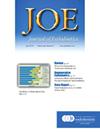热处理NiTi仪器的往复扭转疲劳和力学试验。
IF 3.5
2区 医学
Q1 DENTISTRY, ORAL SURGERY & MEDICINE
引用次数: 0
摘要
本研究旨在评估Reciproc、Reciproc Blue、One RECI和R-Motion的力学性能,特别关注它们的柔韧性和抗屈曲性;并评估了两种不同往复角(150°/30°或70°/30°)下的扭转疲劳行为。方法:共检测仪器160台(每个品牌40台)。弯曲和屈曲试验采用通用试验机(DL 200MF)进行。对于弯曲测试,仪器被放置在45°角,并向地平面弯曲。在屈曲试验中,载荷沿仪器轴方向施加。两项试验均采用20 N称重传感器,试验速度为15 mm/s。扭转试验采用扭力计,试验转速为100 rpm,牙髓马达驱动,往复角度为150º/30º和70º/30º。统计学比较采用单因素方差分析(One-way ANOVA)事后Tukey检验和Student’st检验(α = 5%)。结果:器械的柔韧性差异有统计学意义(P0.05)。然而,150°/30°扭转下的断裂时间没有统计学差异,而70°/30°角度的减小显著增加了所有器械的断裂时间(结论:测试的器械在力学性能上存在显著差异,突出了灵活性、抗屈曲性和扭转行为的可变性。减小往复角度延长了断裂时间,但不影响最大扭矩,强调了往复运动对仪器性能的影响。本文章由计算机程序翻译,如有差异,请以英文原文为准。
Reciprocating Torsional Fatigue and Mechanical Tests of Thermal-Treated Nickel Titanium Instruments
Introduction
This study aimed to evaluate the mechanical properties of Reciproc, Reciproc Blue, One RECI, and R-Motion, specifically focusing on their flexibility and buckling resistance and to assess their torsional fatigue behavior under 2 different reciprocation angles (150°/30° or 70°/30°).
Methods
A total of 160 instruments (40 per brand) were tested. Flexion and buckling tests were conducted using a Universal testing machine (DL 200 MF). For the flexion test, instruments were positioned at a 45° angle and flexed toward the ground plane. In the buckling test, the load was applied along the instrument's axis. A 20 N load cell and a test speed of 15 mm/s were used for both tests. Torsion test was performed using a torsiometer. The test speed was 100 rpm and the instruments were driven by an endodontic motor in 150°/30° and 70°/30° reciprocating angles. One-way analysis of variance post hoc Tukey tests and Student's t test were used for statistical comparisons (α = 5%).
Results
The instruments exhibited significant differences in flexibility (P < .05), with One RECI demonstrating the highest flexibility and Reciproc the lowest. In terms of buckling resistance, Reciproc showed the highest values, while One RECI had the lowest (P < .05). Reciproc and Reciproc Blue displayed greater torque to fracture compared to One RECI and R-Motion (P < .05). Reducing the reciprocation angle did not affect the torque to fracture (P > .05). However, the reduced angle of 70°/30° significantly increased the time to fracture for all instruments when compared to angle of 150°/30° (P < .05).
Conclusions
The tested instruments demonstrated notable differences in their mechanical performance, highlighting variability in flexibility, buckling resistance, and torsional behavior. Reducing the reciprocation angle prolonged the time to fracture without affecting maximum torque, underscoring the influence of reciprocation kinematics on instrument performance.
求助全文
通过发布文献求助,成功后即可免费获取论文全文。
去求助
来源期刊

Journal of endodontics
医学-牙科与口腔外科
CiteScore
8.80
自引率
9.50%
发文量
224
审稿时长
42 days
期刊介绍:
The Journal of Endodontics, the official journal of the American Association of Endodontists, publishes scientific articles, case reports and comparison studies evaluating materials and methods of pulp conservation and endodontic treatment. Endodontists and general dentists can learn about new concepts in root canal treatment and the latest advances in techniques and instrumentation in the one journal that helps them keep pace with rapid changes in this field.
 求助内容:
求助内容: 应助结果提醒方式:
应助结果提醒方式:


